
For the last couple of years, the hottest gadget category for golfers has been personal launch monitors. The $500 and below group has more competition than ever. A surprise hit has been a low-cost, tiny launch monitor from Japan - the PRGR launch monitor.
The original PRGR has been on the market in Japan for several years already under a different brand name (Red Eyes). It was repurposed for the US market in late 2019 as the PRGR HS-120A, and it immediately exploded in popularity.
When I first tested the original PRGR, I was truly surprised by its performance. The product is unsuspecting and basic looking, but it offered accuracy on par with some of the leaders in the industry, such as Trackman, under optimal conditions.
For the past couple of months, I have been testing the newer PRGR (HS-130A). There are some nice upgrades that I'll cover in this review. Overall, this remains one of the best values in the category for its versatility and accuracy.

Special Offer for Practical Golf Readers: We have a special bundle here for Practical Golf readers from PRGR. You can purchase the launch monitor, plus get access to our Insider Membership and a copy of our best-selling book.
What's New With the PRGR (HS-130A)
The original PRGR (HS-120A) performed more than adequately. For $199, you got a launch monitor and swing speed radar that offered accuracy similar to products that cost thousands of dollars more. When I first tested it against my SkyTrak, I was shocked by its performance (especially indoors).
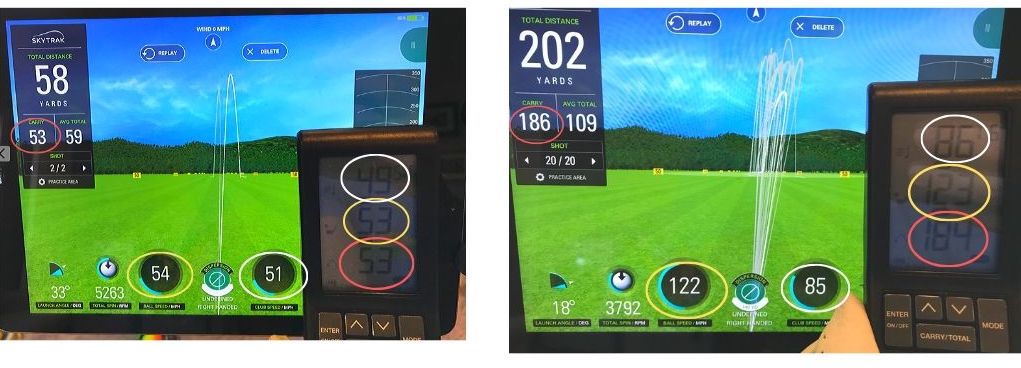
Since then, the PRGR exploded. Countless testimonials poured in with golfers comparing its numbers against products like Trackman and the GCQuad favorably.
Also, it has become a de facto swing speed radar for golfers who are doing speed training (including pro golfers like Jon Rahm).
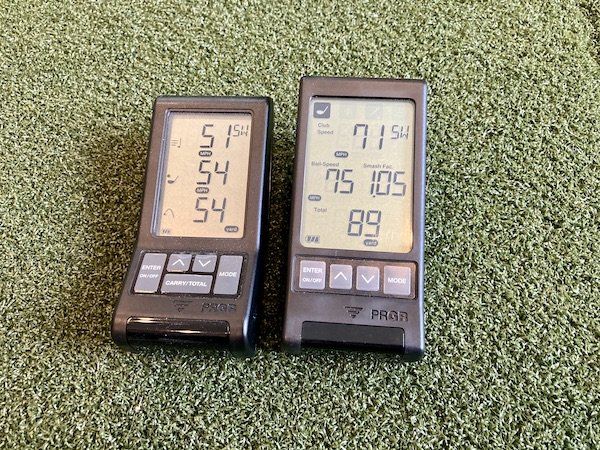
The newer PRGR has a few notable upgrades:
- A higher-quality dual radar sensor
- An improved processor and algorithm to increase accuracy
- Larger, high-resolution display
- Improved wedge measurement (especially on higher-lofted shots)
- Ability to switch between yards and meters
Addressing the Wedge Issue
No product is without its faults. Over the past two years, I've interacted with many golfers who have used the PRGR. For the most part, people were very satisfied with the quality. However, some common issues arose.
The biggest complaint I received was with wedge readings. Because the PRGR's sensor is smaller, it tended to miss some wedge shots, especially for golfers launching the ball higher. For someone like myself, who delofts wedges and starts them on a lower trajectory, that wasn't an issue. One of the fixes was to have golfers stack the original PRGR higher or use a tripod.
Additionally, the original HS-120A had difficulting reading wedges at closer distances, say about 40 yards or less, depending on the setup.
The manufacturer in Japan took this feedback and improved the sensor and algorithm on the newer PRGR HS-130A.
I immediately noticed the difference when I started testing. Generally, I use my SkyTrak launch monitor as a benchmark (I've tested just about every launch monitor on the market at this point on the low end and high end). I know its accuracy, especially on wedge shots, is within a very tight margin of error compared to Trackman or a GCQuad (especially indoors).
The new PRGR and SkyTrak readings were virtually identical, even on shots as low as 20-25 yards.
I also hit shots just about as high as possible with my lob wedge to simulate a golfer who launched the ball much higher. Again, almost identical to my SkyTrak.
In my opinion, this is the biggest upgrade for the HS-130A. I've written before about wedge practice and how honing in your distances with intermediate shots (30 - 80 yards) is some of the most valuable practice any golfer can do. Dustin Johnson routinely credited this practice with his Trackman as the final piece of the puzzle to getting to #1 in the world and winning a major. So it's not above anyone!
Improved Sensor
Perhaps the most important feature of any launch monitor is the quality of the sensor and how the algorithms calculate measurements like carry distance. The original PRGR surprised many because the sensor performed very well for the cost. When you have optimal conditions, such as being outdoors, you can expect more accurate numbers.
That said, when conditions aren't perfect, launch monitors do struggle with misreads or not showing anything at all. I've seen this happen with budget units and even with enterprise-level products that cost $20,000.
As I mentioned, the improved sensor was mostly noticeable on wedge readings. I also found that the HS-130A had much better performance throughout my entire bag, especially indoors, where it's harder for radar-based launch monitors to perform. I'll share some numbers later in the article, but it was clear that the tolerances were tighter with fewer instances of the PRGR not reading the shot at all.
Overall, I'd say the upgrade in components makes an already great value even better. The newer PRGR has a modest price increase of $30 - it's now available for purchase at $229. I still consider it perhaps the best overall value on the market with the upgrade in accuracy. You have to be prepared to put in a little extra work compared to its competition (manually adjusting clubs, no app) and make sure you have it set up properly (I'll give some tips on that later).
Either way, at $229, I still think this is a viable option for golfers who have a lower budget or don't want enhanced features like an app that products like the Swing Caddie SC300i and Rapsodo MLM offer.
The Screen is Larger
Another noticeable upgrade with the HS130-A is a larger, higher resolution screen. While this isn't as big of a deal as the sensor improvement, it does make the PRGR a little more user-friendly.
Instead of toggle back and forth to see measurements like swing speed, ball speed, and smash factor, they are displayed on the entire screen. The only thing you would need to toggle between are carry versus total distance.
The new PRGR functions mainly the same as the prior model. You will need to change clubs for the best accuracy manually.
How the PRGR Performed Indoors
After years of testing launch monitors and measuring my on-course yardages, I can quickly tell how a product is performing. After a couple of months, I can tell you that the new PRGR performed exceptionally well for me indoors. I saw swing speed, ball speed, and yardage measurements that were almost identical to all of the other data I've collected throughout my entire bag.
The original HS-120A was no slouch indoors in my home studio, but the newer HS-130A had even tighter margins. But with any launch monitor, especially inside, conditions do matter.
You'll want good lighting and enough distance behind and in front of the ball (typically about 3-5 feet in both directions). Having the monitor level (at minimum) to the playing surface is a must as well.
Also, the color of the net and what's behind the net can affect readouts as well. I've had golfers who struggle to get readings on launch monitors (PRGR and other models) when it's too "busy" for the sensor to pick up. For example, if you had a white net in your garage and all kinds of stuff behind it with different colors, the monitor can struggle to track the ball.
I have a black net in my home setup, a grey wall behind it, and proper lighting, so I had no issues with the PRGR picking up almost every shot.
However, it does take some time to find optimal positions and set up to get my best numbers. This goes for any of the budget launch monitors. I found that having the unit closer to the ball (about 3 to 3.5 feet) gave me the most accurate numbers with my wedges.
As I progressed through my bag, I found that moving it back to about 5 feet was more accurate with 7-iron and beyond. Additionally, since my irons have aggressive lofts, and I also deloft quite a bit at impact, I noticed that choosing an extra iron as my setting gave me the best readouts. So if I were hitting a 6-iron, I would set the PRGR to a 5-iron. This helps the unit with its calculations.
But please note that you might have to do a little tinkering of your own, or perhaps none at all, to get the best results.
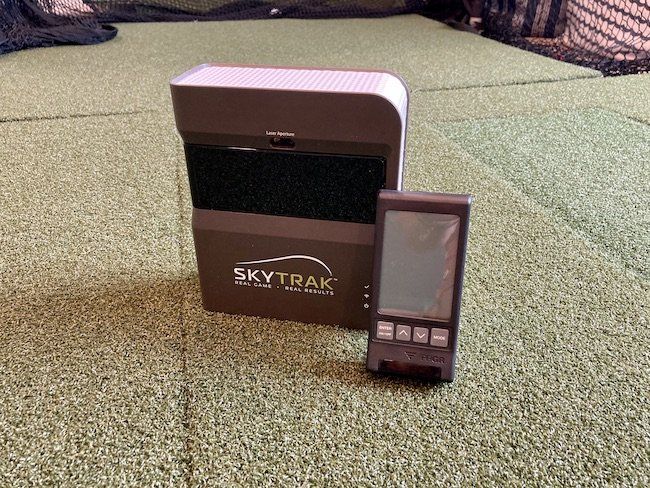
Here are some numbers from a session versus my SkyTrak. Keep in mind that each launch monitor has its own calculation methods and measurements, but once again, the PRGR delivered against a proven product that costs 10x the amount.
Long story short, the new PRGR continues its ability to accurately track your swing speed, ball speed, and carry/total yardages indoors under proper conditions. The new sensor and calculation methods have tightened things up even more.
If you are looking for a quality net to go along with the PRGR, we recommend reading our Spornia SPG-7 review.
Outdoor Performance and Some Other Considerations
When radar-based launch monitors have more space to see the ball travel, they typically perform better. There is one major caveat you should be aware of - range balls.
I like testing launch monitors inside because I can control the golf ball I am using. When I go to the range, I am at the mercy of the balls they are using. In this article, I explored how practice balls can vary greatly in quality, and oftentimes you won't get the same results you would with a premium ball. So you do have to take your results with a minor grain of salt.
Unsurprisingly, I found that the new PRGR did an excellent job of showing carry distances on the range. It registered almost every shot with relatively accurate yardages I hit, with few exceptions.
Again, don't expect perfection. No launch monitor, regardless of the cost, gets it right every time.
Lastly, I found that the PRGR (and many other products in this category) perform best when you're striking the ball relatively well. If you're hitting a few "duds" out there, expect it to struggle with reading. Although you should have a pretty good sense if you've had an extremely errant swing anyways.
Swing Speed Training
One of the biggest reasons the original PRGR became such a hit is that it is a very accurate swing speed radar. It's one of the few launch monitors out there that will accurately record your swing speed without hitting a ball. More expensive models like the Swing Caddie SC300i and Rapsodo MLM cannot measure swing speed without hitting a golf ball. As such, the PRGR has become one of the preferred methods of tracking swing speed for professional golfers, coaches, and golfers of all levels.
If you are training with a system like SuperSpeed Golf, this is critical feedback to have. I've been working on my swing speed for years now, and I can tell you that having feedback on every swing helps tremendously. If you don't have a method of tracking your swing speed, you're essentially flying blind and can't track your progress.
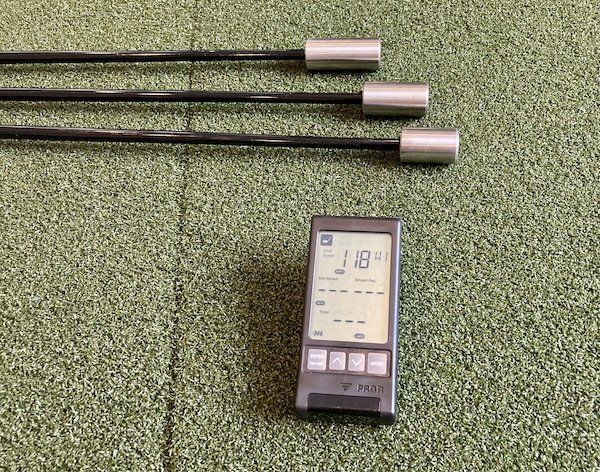
Compared with the original PRGR, the HS130-A gave me almost identical swing speed readings when training with the SuperSpeed sticks, so not much has changed on that front. If it ain't broke, don't fix it!
One thing I did notice is that the newer model does not measure swing speed from the side. With the original PRGR, I found that I got my best readings with the radar placed to my side, a few inches in front of where the golf ball would be. The newer model performed best for me, about 3 feet behind me.
Another small benefit is that the new PRGR has enhanced measurements for other sports. You can record bat speed and ball speed in baseball or other sports like soccer or tennis.
Should You Upgrade From the HS-120A?
I'm sure many of you reading this might have a little FOMO if you have the original PRGR. In my opinion, I don't think it's necessary to upgrade unless you want the bigger screen and enhanced accuracy (especially on wedges). From my interactions with most people who have purchased the HS-120A, they are quite satisfied.
Where Does the PRGR Launch Monitor Fit In?
I continue to be surprised by this miniature launch monitor. The PRGR doesn't look as polished as its competition, but it is excellent at providing carry distances, ball speeds, and swing speed data that is close (sometimes identical) to what I know are my typical numbers. The versatility of using it indoors and outdoors is a plus, though you might see varying results based on how much space you have inside and other conditions. And if you are training for increased swing speed, I'd say this product is a must.
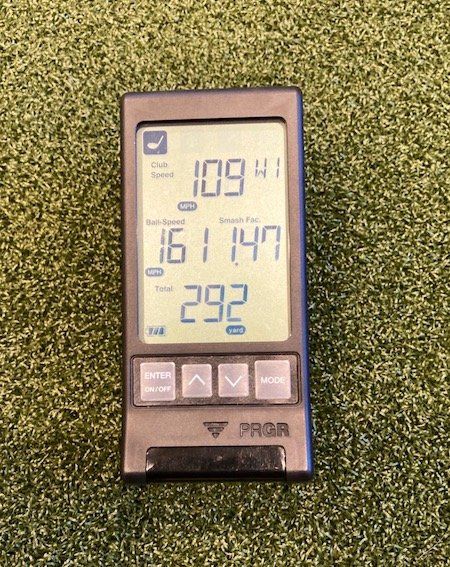
Overall, the PRGR is for those looking to buy a launch monitor that is very basic and doesn't cost much. It is definitely a no-frills offering. There is no accompanying app that models like the Swing Caddie SC300i, Rapsodo MLM, or FlightScope mevo have. Another budget model that costs a little more is the Swing Caddie SC200 Plus, which has a remote control to adjust the club you are using and does display loft (along with a few other features).
For $229, you can't expect much, but I believe the product continues to "over-deliver." The competition has more features if that's what you're looking for. But you'll be hard-pressed to find a better overall value, in my opinion, especially if you are on a limited budget and want to get swing speed, ball speed, and distance.
You can purchase the PRGR bundle for Practical Golf readers here. Also, this article explores ideas on how to practice with launch monitors effectively.
Here are other articles I've written on launch monitors:
We care about the protection of your data Read our Privacy Policy